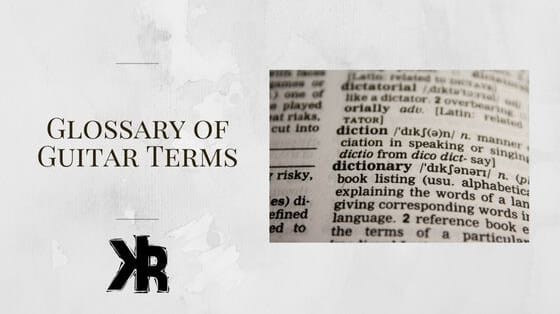Table of Contents
Whether you’re just dipping your toes into guitar playing, an old hand at it, or simply looking to add some polish to your abilities, it’s vital to know the lingo. Guitar terms can feel like a whole other language, can’t they?
Don’t worry, we’ve got your back. We’ve assembled a detailed yet simple-to-digest list of guitar terminology for you. The aim is simple: to cut through the jargon and make the musical chatter clearer. So, get ready, your musical journey just got a little easier.
It covers parts, techniques, slang, lingo, and more! From basic pickups and strumming methods to complicated musical styles and terminology. We break down all the components to give you the knowledge you need to help master the guitar.
Common Guitar Terms
Starting from A and ending near Z! We have your guitar terms below!
Another article for further learning: guitars part names.
Acoustic
A type of guitar that uses a resonant hollow body to produce sound. Rather than pickups and an amplifier.
Amplifier
An electronic device that is used to amplify the signal from a guitar. This makes it loud enough to be heard through a speaker.
Action
The guitar action is the distance between the strings and the fingerboard. This can affect the playability and feel of the guitar.
Arpeggio
A method that requires playing the notes of a chord individually. Rather than strumming the chord all at once.
Artificial Harmonics
A technique that involves playing a harmonic. It’s done by using a finger from the fretting hand to lightly touch the string at a specific point. All while simultaneously plucking the string with the picking hand.
Attack
The way in which a note is played or articulated, which can affect its clarity and definition. A sharp attack involves plucking or picking the string firmly with a clear, defined tone. A soft attack requires a more gentle, muted approach.
Arrangement
The way in which a piece of music is structured or organized. Including the order of the parts, the instrumentation, and the overall form.
Alternate Picking
A style that requires alternating between downstrokes and upstrokes when picking. With the goal of playing as evenly and efficiently as possible.
Accidental
A symbol used to indicate a sharp, flat, or natural. This temporarily changes the pitch of a note from its diatonic value.
Accent
An emphasis or stress placed on a particular note or beat. Typically, by playing it louder or with more articulation.
Bass Note
The lowest note in a chord or a melodic line.
Baseball Bat Guitar Neck
This term is used to describe a guitar neck that is so thick, it’s almost hard to play. It’s found on electric guitars and has a taper that gets thicker as it approaches the body.
Bridge
The part of the guitar that holds the strings in place on the body. It allows them to be raised or lowered to adjust the pitch.
Bending
The tactic of pressing down on a string with the fingers and then pulling it upward or downward to change the pitch.
Body
The main part of the guitar, which gives the instrument its shape and resonance.
Back and Sides
The lower parts of the guitar body, or back and sides. They are made of tonewood such as mahogany or rosewood. They also contribute to the overall tone of the instrument.
Blues
A style of music that originated in the African-American communities of the southern United States. It’s characterized by a 12-bar chord progression. Also, a call-and-response structure, and a specific blues scale.
Bright
A sound that is clear, crisp, and well-defined, often with a strong high-end presence.
Barre chord
A chord that is played with the index finger placed across all the strings at a specific fret. This allows the player to play a chord shape with a single finger.
Bridge Pins
Small pins that are used to hold the strings in place at the bridge of a guitar.
Belly Bulge
A bulge or dome that can sometimes form on the top of an acoustic guitar. It’s due to the tension of the strings pulling against the top of the instrument in poor environments.
Beat
The underlying pulse or rhythmic structure of a piece of music.
Bite
Heavy, aggressive music with a sharp, cutting sound.
Chucking
A technique of playing the guitar with a percussive, chucking motion. It’s typically used in folk and blues music.
Clean
A type of guitar sound that is clear and uncolored, with little or no distortion.
Crunchy
A guitar sound that’s slightly distorted and has a biting, punchy quality.
Capo
A small clamp that is placed on the neck of the guitar. It’s used to raise the pitch of the strings and enable the playing of songs in different keys.
Cutaway
A shape that is cut out of the body of the guitar. Typically, on an electric or acoustic-electric guitar. It allows easier access to the higher frets.
Chambering
The process of hollowing out the body of a solid-body guitar. It’s done to reduce weight and increase resonance.
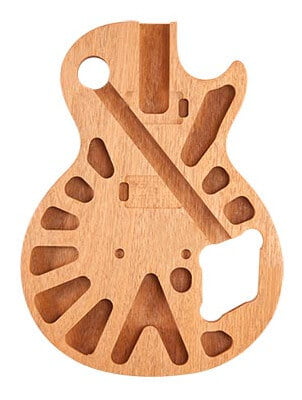
Compression
An effect that reduces the dynamic range of a signal. It makes the loud parts quieter. But also the quiet parts louder. This can create a smoother, more even sound and help to even out the volume of different notes or passages.
Chorus
An effect that creates a thick, shimmering sound. It’s done by combining a slightly detuned version of the original sound with the dry signal.
Chord
A combination of three or more notes played simultaneously. Thus creating a harmonious sound.
Chord Diagram
A visual representation of a chord. It displays the positions of the fingers on the fretboard.
Cold
A tone that is thin, harsh, and clinical, often with a pronounced high-end presence.
Clarity
A clear, well-defined sound, that is easy to distinguish. Normally with a strong presence in the high frequencies.
Cut
A tone that is bright and well-defined, with a strong presence in the high frequencies.
Chromatic
A scale that consists of all 12 notes of the chromatic scale, played in a specific order.
Camber
The curvature of the neck of a guitar. This determines the action of the strings and the playability of the instrument.
Distortion
A kind of guitar sound that is heavily distorted and crunchy.
Dynamics
The variations in volume and intensity in a piece of music.
Delay
An effect that creates a repetition of the original sound. This happens at a specified time interval, creating the illusion of an echo.
Definition
A sound that is distinct and well-defined. With a strong attack and a defined transient response.
Drop D Tuning
A guitar tuning in which the low E string is lowered one whole step to D, resulting in a lower, heavier sound.
Downstroke
A picking tactic that starts from the top of the string and moves downwards. Typically used in alternate picking and strumming.
Electric
A type of guitar that uses pickups to convert the vibrations of the strings into an electrical signal. It’s then amplified through an amp to produce sound.
Effects Pedals
Small, portable devices that can be placed on the floor or a pedal board. They are used to alter the sound of a guitar by adding various effects such as reverb, delay, or distortion.
Economy Picking
A technique that requires alternating between downstrokes and upstrokes. All when picking in a way that is efficient and economical.
EQ
A circuit that allows the player to adjust the levels of the different frequency ranges (bass, mids, treble) in the signal. Ultimately shaping the tonal character of the sound.
Extension
A note that is added to a chord beyond the seventh, such as a ninth, eleventh, or thirteenth.
Envelope Filter Pedal
An effect pedal that filters the frequency content of the signal based on the envelope of the input. It produces a wah or sweeping effect.
Fingerboard
The long, flat surface on the neck of the guitar that is divided into frets, over which the strings are played.
Fret
A thin metal bar that is embedded in the fingerboard. It’s used to create different notes by pressing the strings against it.
Fanned Frets
A guitar with a neck that has frets that are angled or fanned to compensate for the different string lengths. This results in improved intonation and playability.
Fingerpicking
The method of using the fingers to pluck the strings individually or in patterns.
Fuzz
A type of guitar sound that is heavily distorted and has a smooth, velvety quality.
Feedback
A high-pitched squealing sound. It can occur when the sound from an amplifier’s speakers is picked up by the guitar’s pickups. The squeal is a result of it being amplified again.
Flanger
A sort of effect that creates a sweeping, whooshing sound. It’s created by combining a delayed version of the original sound with the dry signal.
Flatpicking
A method of playing the guitar with a flat pick. Allowing for fast, articulate single-note runs and a bright, punchy sound.
Fat
A sound that is full, round, and warm, often with a strong low-end presence.
Fizz
A tone that is overly bright and harsh, with an unpleasant or fizzy quality.
Flatwound
A guitar string type that has a flat wire wrapped around a core, producing a smooth, mellow sound.
Gain
The level of amplification or overdrive applied to a signal, typically measured in decibels (dB).
Ghost Note
A muted, percussive note that is played lightly and with a quick, staccato attack. Often used in funk and groove-based music.
Gig
A live performance by a musician or a band.
Headstock
The guitar part located at the top of the neck, where the strings are attached.
Half Step
The smallest interval in Western music, equal to one semitone.
Hollow Body
A type of guitar that has a large, hollow body, which is designed to produce a rich, warm tone.
Hybrid Picking
A tactic that involves using a combination of a pick and the fingers to play the strings.
Harmonics
A technique that involves playing a note by lightly touching the string at a specific point. Rather than pressing it down onto a fret. This produces a high, ringing sound called a natural harmonic or overtone.
Harmony
The combination of two or more notes played simultaneously, creating a harmonious sound.
Honky
A kind of sound that is pronounced and emphasized in the midrange frequencies. Often with a nasal or boxy quality.
Humbucker
A type of pickup that consists of two single-coil pickups wired in series with opposite polarity. Thus resulting in a more balanced, less noisy sound.
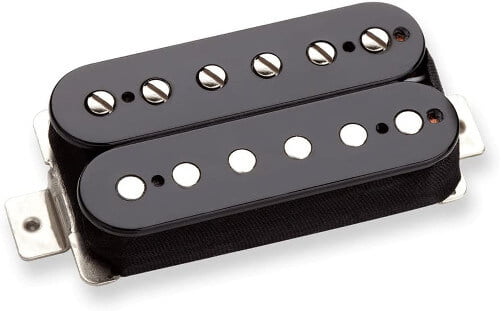
Hammer-on
The method of playing a note by hammering down on the string with the fretting hand.
Inversion
A chord that has the root note in a different position than the lowest. This results in a different quality or voicing of the chord.
Inlays
Inlays are the fret markers along the neck. They indicate the position of the frets in a particular order. They are made of many materials like pearl, abalone, or plastic.
Interval
The distance in pitch between two notes.
Intonation
The accuracy of the pitch of the strings. This can be adjusted by moving the saddle on the bridge.
Ice Pick
A description of a sound that is thin, piercing, and overly bright. Often with a harsh, uncomfortable quality.
Jazz
A music style that started in the southern United States. It’s characterized by improvisation, complex chord structures, and a swing feel.
Jam
A casual, informal musical performance or rehearsal. Often with a group of musicians improvising together.
Key
The tonal center of a piece of music, determined by the scale and chords used.
Key Signature
A group of symbols placed at the beginning of a piece of music. This indicates the key in which the music is written.
Legato
A tactic that involves playing smoothly and seamlessly from one note to the next. All without any break or separation between the notes.
Lick
A short, distinctive phrase played on the guitar. Typically consisting of a series of single notes. Or a combination of single notes and chords.
Lead
Another term for a solo or a lead guitar part.
Looper Pedal
A sort of effect pedal that allows the player to record a short phrase or loop of music. Then, play it back repeatedly, allowing for the creation of complex layers of sound.
Luthier
A craftsman who builds or repairs stringed instruments, such as guitars.
Mode
A scale. One that is derived from a parent scale. But has a different pattern of whole and half steps and a unique character or flavor.
Melody
A series of single notes played or sung in a specific order to create a musical line.
Middy
A tone that is strong in the midrange frequencies, often with a pronounced honk or cut quality.
Modulation
The process of changing from one key to another during a piece of music.
MIDI
The acronym for Musical Instrument Digital Interface. A standard protocol for communicating musical information between electronic devices. Such as synthesizers, computers, and drum machines.
Major
A musical scale or chord that has a bright, happy character, often associated with the Ionian mode.
Minor
A chord or scale that has a sad, introspective character, often associated with the Aeolian mode.
Natural
A symbol used in notation to cancel the effect of a sharp or a flat.
Nut
A guitar nut is a small strip of material, usually made of bone, plastic, or metal. It’s located at the top of the neck, where the strings pass over from the headstock to the fingerboard.
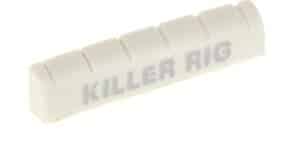
Neck
The long, thin part of the guitar that extends from the body and supports the fingerboard.
Neck Joint
The point where the neck of the guitar attaches to the body.
Note
A symbol used in music to represent a specific pitch and duration.
Natural Harmonic
A type of harmonic that is produced by lightly touching the string at specific points along the fingerboard. Resulting in a pure, bell-like tone.
Noise Gate
A category of effect that reduces or eliminates unwanted background noise in the signal, such as hum or hiss.
Octave
An interval between two notes. Separated by an interval of 12 half steps, or one full octave.
Open String
A string that is played without pressing down on any frets. Thus producing the open pitch of the string.
Open Chord
A chord that is played with one or more open strings. This results in a fuller, more resonant sound.
Overdrive
A type of guitar sound that is characterized by a slight to moderate amount of distortion.
Palm Muting
A tactic that requires resting the picking hand on the strings near the bridge to produce a muted, throaty sound.
Patch Cable
A short cable that is used to connect different pieces of audio equipment or effect pedals together.
Pinch Harmonics
A technique that entails lightly touching the string with the thumb of the picking hand. All while simultaneously plucking the string to produce a harmonic.
Phase Shifter
A style of effect that creates a swirling sound by shifting the phase of the original tone.
Punchy
A sound that is tight, focused, and articulate, with a strong attack and a defined transient response.
Pentatonic Scale
A five-note scale that is commonly used in blues, rock, and other styles of music.
Pick
A small, pointed piece of material, such as plastic or tortoiseshell. It’s used to pluck the strings of a guitar.
Pitch
The highness or lowness of a sound, determined by the frequency of the sound wave.
Plectrum
Another term for a guitar pick.
Pickguard
A piece of material that is mounted on the body of a guitar. It protects the finish from being scratched by the pick.
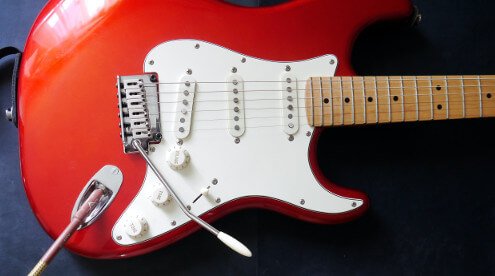
Power Chord
A chord that consists of the root note and the fifth. They are played on the lower strings of the guitar and are often used in rock and metal music.
Pickup
A device that converts the vibrations of the strings into an electrical signal. It can then be amplified through an amp.
Picking
The method of using a pick to play the strings.
Pull-off
The manner of playing a note by pulling the string off the fingerboard with the fretting hand.
Quarter Note
A note that is equal in duration to one quarter of a whole.
Reverb
An effect that simulates the sound of an echo or reverberation in a physical space. It adds depth and dimension to the sound.
Raw
Unpolished, intense music that has a visceral feel and an immediate impact on listeners.
Riff
A riff is a short, catchy phrase played on the guitar. Typically consisting of a series of chords or single notes played in a repeating pattern.
Rock
A style of music that originated in the 1950s and is characterized by a heavy beat. It has a distorted electric guitar sound, and powerful vocals.
Root
The main pitch of a chord or scale, upon which the rest of the notes are built.
Roundwound
A type of guitar string that has a round wire wrapped around a core. It produces a bright, punchy sound.
Rest
A symbol used in music notation to indicate a silent pause.
Rhythm
The pattern of regular or irregular pulses created by the placement of sounds and silences in time.
Saddle
A small, adjustable piece that is part of the bridge, used to set the string height and intonation.
Strumming
The technique of using a strumming motion to play the strings with the fingers or a pick.
Sliding
The technique of moving the finger up or down the string to change the pitch.
String Gauge
The thickness of the strings, which can affect the playability, tone, and longevity of the strings.
Solid-body
A type of guitar that has a solid body, which is designed to produce a brighter, punchier tone.
Scale
A series of notes played in a specific pattern, ascending or descending in pitch.
Scale Length
The distance between the nut and the saddle. This determines the spacing of the frets and the overall feel of the guitar.
Staccato
A method that requires playing short, detached notes with a sharp, crisp sound.
Slap Harmonics
A technique that entails striking the string with the side of the thumb. Then immediately releasing it to produce a harmonic.
Sweep Picking
A tactic that calls for using a rapid, fluid picking motion to play arpeggios.
Sustain
The length of time that a note or chord will ring out after it is played.
Seventh Chord
A chord that consists of four notes, typically a root note, a third, a fifth, and a seventh.
Shred
A style of playing that involves fast, virtuosic runs and solos. Often featuring alternate picking, string skipping, and legato phrasing.
Speaker
A device used with an amplifier to make sound louder. The speaker turns the electrical signal into sound after amplification. A great example of this are bookshelf speakers.
Slide Guitar
A technique of playing the guitar with a sliding object. Such as a glass bottle or a metal slide, to produce a smooth, gliding sound.
Sizzle
A sound that is bright and shimmering, with a strong presence in the high frequencies.
Setup
The adjustment of the various components of a guitar. Such as the action, intonation, and string height, to optimize its playability and tone.
String Winder
A tool that is used to quickly and efficiently change the strings on a guitar.
Standard Tuning
The most common tuning for a guitar, in which the strings are tuned to the pitches E, A, D, G, B, and E (low to high).
Step
An interval of a whole or a half step between two notes.
Strap
A strip of material that is worn over the shoulder and used to support the weight of the guitar.
Strap Locks
A device that is used to securely fasten the strap to the guitar and prevent it from slipping off.
Single-coil
A type of pickup that consists of a single coil of wire wrapped around a magnet, producing a bright, punchy sound.
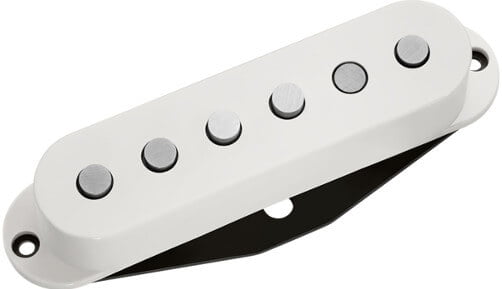
String Skipping
A technique that involves playing a sequence of notes that skip over one or more strings. Rather than playing all the strings linearly.
Sharp
A symbol used in music to indicate that a note should be raised by a half step.
Semitone
The smallest interval in Western music, equal to one-half step.
Stompbox
Another term for a guitar effect pedal.
Sheet Music
A written representation of a piece of music, including the melody, chords, and lyrics.
Staff
The lines and spaces on which music is written. Consisting of a series of five lines and four spaces.
Tone Knob
A knob on an amplifier or guitar that is used to control the tone of the sound. Usually by adjusting the levels of the bass, midrange, and treble frequencies.
Tuning Keys
The small mechanical devices located on the headstock of the guitar. Used to tune the strings by turning them clockwise or counterclockwise.
Top
The upper part of the guitar body. Normally made of a tonewood such as spruce or cedar and plays a major role in the overall tone of the instrument.
Tremolo
A vibrato system that is built into the bridge of the guitar. It allows the player to alter the pitch of the strings by using a lever.
Tapping
A technique that involves using the picking hand to tap the strings against the fingerboard. Used to produce a clear, bell-like tone.
Tone
The character or quality of a sound. Influenced by factors such as the type of guitar, the pickups, the amp, and the effects pedals being used.
Timbre
The unique tonal characteristics of a particular instrument or sound. Which sets it apart from other instruments or sounds.
Triad
A chord that consists of three notes, typically a root note, a third, and a fifth.
Thick
A sound that is rich, full, and heavy, often with a strong low-end and midrange presence.
Tablature
A system of notation that uses numbers to indicate the position of the fingers on the frets. Rather than standard musical notation.
Transcription
The undertaking of writing out a piece of music in standard musical notation. Either by ear or from a recording.
Transpose
The process of changing the pitch of a piece of music by a specific interval, either up or down.
Tuner
A device that is used to accurately tune the strings of a guitar to the correct pitch.
Truss Rod
A rod that is located inside the neck of a guitar. It’s used to adjust the curvature of the neck and the action of the strings.
Toggle Switch
A toggle switch is often used to control the various functions of the instrument. Such as selecting between different pickups or activating certain effects.
Tempo
The speed at which a piece of music is played, typically measured in beats per minute.
Time Signature
A symbol placed at the beginning of a piece of music. It indicates the meter and the beat of the music.
Treble
The high frequencies of a sound, typically above 1000 Hz.
Tube
A type of vacuum tube that is used in some guitar amplifiers to amplify the signal.
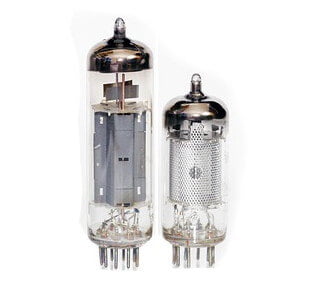
Upstroke
A picking motion that starts from the bottom of the string and moves upwards. Typically used in alternate picking and strumming.
Voicing
The way in which a chord is played or arranged, including the order and spacing of the notes.
Volume Knob
A knob either on an amplifier or a guitar that is used to control the volume of the sound.
Vibrato
A technique that involves rapidly bending the string back and forth to create a wavering effect.
Valve
Another term for a vacuum tube.
Volume Swells
A tactic of gradually increasing the volume of a note. Normally by using the volume control on the guitar or an effect pedal.
Warm
A sound that is rich, full, and smooth, with a strong low-end and midrange presence.
Wah Pedal
An effect pedal that produces a wah sound by filtering the frequency content of the signal.
Whammy Bar
A lever or bar that is attached to the bridge of a guitar and is used to produce vibrato or pitch bends.
Whole Step
An interval of two half steps, or one whole tone.

